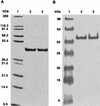Purification, potency, and efficacy of the botulinum neurotoxin type A binding domain from Pichia pastoris as a recombinant vaccine candidate
- PMID: 9746584
- PMCID: PMC108595
- DOI: 10.1128/IAI.66.10.4817-4822.1998
Purification, potency, and efficacy of the botulinum neurotoxin type A binding domain from Pichia pastoris as a recombinant vaccine candidate
Abstract
Recombinant botulinum neurotoxin serotype A binding domain [BoNT/A(Hc)], expressed in Pichia pastoris, was developed as a vaccine candidate for preventing botulinum neurotoxin type A (BoNT/A) intoxication. After fermentation and cell disruption, BoNT/A(Hc) was purified by using a three-step chromatographic process consisting of expanded-bed chromatography, Mono S cation-exchange chromatography, and hydrophobic interaction chromatography. Two pools of immunogenic product were separated on the Mono S column and processed individually. Both products were more than 95% pure and indistinguishable by sodium dodecyl sulfate-polyacrylamide gel electrophoresis, Western blot analysis, and enzyme-linked immunosorbent assay (ELISA). Each protein was assayed for potency in mice at immunogen doses ranging from 2.4 ng to 10 microg, followed by challenge with 1,000 mouse intraperitoneal 50% lethal doses (i.p. LD50) of BoNT/A. The calculated 50% effective dose for both peaks was approximately 0.1 microg/mouse. Peak 1 was evaluated further in a mouse efficacy assay. Mice were injected either once, twice, or three times at five different doses and subsequently challenged with 100,000 mouse i.p. LD50 of BoNT/A. In general, multiple injections protected better than one, with complete or nearly complete protection realized at doses of >/=0.5 microg/mouse. Serum neutralization and ELISA titers were also determined. Tellingly, 82 of 83 mice with antibody titers of >/=1, 600, as measured by ELISA, survived, but only 6 of 42 mice with titers of </=100 survived. This work shows that the purified BoNT/A(Hc) produced was a highly effective immunogen, able to protect against a high challenge dose of neurotoxin.
Figures




Similar articles
-
Fermentation, purification, and efficacy of a recombinant vaccine candidate against botulinum neurotoxin type F from Pichia pastoris.Protein Expr Purif. 2000 Apr;18(3):327-37. doi: 10.1006/prep.2000.1200. Protein Expr Purif. 2000. PMID: 10733887
-
Expression of Hc fragment from Clostridium botulinum neurotoxin serotype B in Escherichia coli and its use as a good immunogen.Hum Vaccin. 2010 Jun;6(6):462-6. doi: 10.4161/hv.6.6.11709. Epub 2010 Jun 1. Hum Vaccin. 2010. PMID: 20519939
-
Evaluation of a recombinant Hc of Clostridium botulinum neurotoxin serotype F as an effective subunit vaccine.Clin Vaccine Immunol. 2008 Dec;15(12):1819-23. doi: 10.1128/CVI.00239-08. Epub 2008 Oct 8. Clin Vaccine Immunol. 2008. PMID: 18845829 Free PMC article.
-
Development of vaccines for prevention of botulism.Biochimie. 2000 Sep-Oct;82(9-10):955-66. doi: 10.1016/s0300-9084(00)01173-1. Biochimie. 2000. PMID: 11086225 Review.
-
Botulinum neurotoxin vaccines: past, present, and future.Crit Rev Immunol. 2007;27(4):303-18. doi: 10.1615/critrevimmunol.v27.i4.20. Crit Rev Immunol. 2007. PMID: 18197811 Review.
Cited by
-
Oral vaccination with an adenovirus-vectored vaccine protects against botulism.Vaccine. 2013 Feb 4;31(7):1009-11. doi: 10.1016/j.vaccine.2012.12.054. Epub 2013 Jan 4. Vaccine. 2013. PMID: 23295065 Free PMC article.
-
Recombinant Botulinum Neurotoxin Hc Subunit (BoNT Hc) and Catalytically Inactive Clostridium botulinum Holoproteins (ciBoNT HPs) as Vaccine Candidates for the Prevention of Botulism.Toxins (Basel). 2017 Sep 3;9(9):269. doi: 10.3390/toxins9090269. Toxins (Basel). 2017. PMID: 28869522 Free PMC article.
-
Bacillus subtilis: a temperature resistant and needle free delivery system of immunogens.Hum Vaccin Immunother. 2012 Jul;8(7):979-86. doi: 10.4161/hv.20694. Epub 2012 Jun 15. Hum Vaccin Immunother. 2012. PMID: 22699442 Free PMC article. Review.
-
Nanogel antigenic protein-delivery system for adjuvant-free intranasal vaccines.Nat Mater. 2010 Jul;9(7):572-8. doi: 10.1038/nmat2784. Epub 2010 Jun 20. Nat Mater. 2010. PMID: 20562880
-
Immunologic and Protective Properties of Subunit- vs. Whole Toxoid-Derived Anti-Botulinum Equine Antitoxin.Vaccines (Basel). 2022 Sep 14;10(9):1522. doi: 10.3390/vaccines10091522. Vaccines (Basel). 2022. PMID: 36146601 Free PMC article.
References
-
- Anderson J H, Lewis G E. Clinical evaluation of botulinum toxoids. In: Lewis G E, editor. Biomedical aspects of botulism. New York, N.Y: Academic Press; 1981. pp. 233–246.
-
- Chiruvolu V, Cregg J M, Meagher M M. Recombinant protein expression in an alcohol oxidase-defective strain of Pichia pastoris in feedbatch fermentations. Enzyme Microbiol Technol. 1997;21:277–283.
-
- Clare J J, Rayment F B, Ballantine S P, Sreekrishna K, Romanos M A. High-level expression of tetanus toxin fragment C in Pichia pastoris strains containing multiple tandem integrations of the gene. Bio/Technology. 1991;9:455–460. - PubMed
MeSH terms
Substances
LinkOut - more resources
Full Text Sources
Other Literature Sources
Medical

